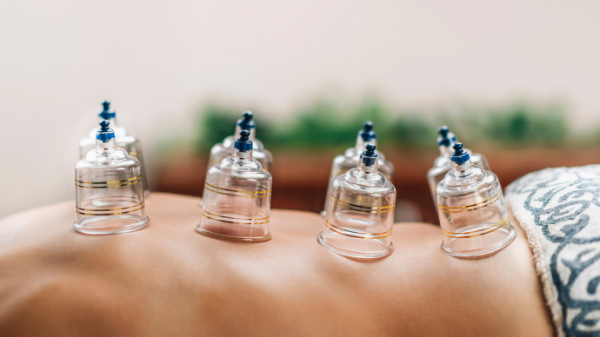When 23-times Olympic gold medallist Michael Phelps finished first at the 2016 Rio Olympics, global attention was drawn on the pepperoni-like rings on his back. While in the West, cupping is a wellness buzzword, flaunted by Hollywood biggies like Jennifer Anniston and Gwyneth Paltrow, in Asia we know that cupping is a centuries old Chinese therapy practiced under the Traditional Chinese Medicine (TCM) which uses localized pressure to promote healing and reduce pain in the body. Attributed for removing toxins, chronic pain, muscle tension, used in ancient days to treat lung conditions like bronchitis and pneumonia – cupping is a therapy worth the purple splotches!
Here’s what you need to know:
What is cupping?

Cupping is a form of traditional Chinese medicine that uses special glass cups that are warmed with flames to create a vacuum that applies suction to the targeted areas of the body. It is non-invasive and does not hurt.
What are the benefits of cupping?
Cupping is commonly used to treat muscle pain and promote blood circulation. Believed as a way to “create an exit for all toxins within the body to be released”, explains Dr. Michelle Zhang, Balance Health’s in-house TCM doctor. “The combination of suction can activate the self-healing power of the body”, she says.
In fact, recent research suggests that cupping affects the body’s own natural healing ability. According to Dr. Clara Chan of Oriental Health, “When the skin surface is stimulated by the suction of the cups, the body sends to activate its neuroendocrine-immune system — [the body’s regulatory network that consists of the nervous, endocrine and immune system], producing therapeutic effect from within.
Other benefits include:
- Relieving muscle, back, shoulder and neck pain, including conditions such as fibromyalgia
- Help treat chronic muscle pain and muscle injuries
- Promote muscle relaxation and reduce anxiety
- Detoxing organs, improve blood circulation and alleviate digestive problems, such as bloating, gastric reflux and constipation conditions.
- Boost immunity and help relieve cold & flu
- Help treat Bell’s palsy (a facial muscle weakness or paralysis)
- Help reduce Acne
How does it work and feel?

For first time cupping patients, it may be difficult at first to feel comfortable lying faced down and shirtless while someone lights up a set of glass cups with flames then places them on your back. But the sensation is oddly comfortable. The heat is warm, and the suction is at first tight but you begin to feel the release of stagnant energy within.
Before the actual treatment, an initial survey of the patient’s lifestyle and observation of the his/her pulse, tongue and skin colour by the TCM doctor will provide a clearer understanding the patient’s condition. The therapy begins with “flash cupping”, a method that involves rapidly placing and removing the suction cups on different areas of the body. This helps reveal which areas of the body have the most blood stasis or dampness (water retention) which helps determine which areas to target. The cups are then left on for up to 10 minutes.
The different types of Cupping:
Besides flash cupping and dry cupping (described above), there is also wet cupping. The difference between wet cupping and dry cupping is that a tiny incision is made on the skin let out some blood — said to promote better blood circulation. The type of cupping and number of cups used, as well as positions varies from person to person, depending on their condition.
Various cupping tools can also be used though glass is most effective, while silicone can be used to target trickier areas such as the joints. Plastic cups, on the other hand are used manually which can be convenient for those who prefer to practice cupping on themselves.
What do the red marks mean?
After the treatment, patients will bare a series of bruised circles on their bodies. Although the marks can take a few days to disappear, they are painless. Of course, many will be curious to understand just what these markings mean.
The marks can appear in different shades from light to dark, indicating the level of dampness or stagnation within the body. The darker the mark, the higher the level of toxins and stagnant energy, while a paler shade indicates dampness or high levels of water retention, though pale purple marks can mean qi blood deficiency. Don’t hesitate to ask your TCM doctor if there is anything that you don’t undeerstand.
Who should avoid cupping?

- Pregnant women
- People with underlying conditions such as cancer and severe chronic diseases, such as haemorrhage, tumours, or tuberculosis
- People who have suffered a cardiac arrest in the last six months or have a history of strokes
- People with bleeding disorders, blood clotting problems or who are anemic
- People with skin conditions including including eczema and psoriasis and anyone with open wounds
How often can I go cupping?
For general pain management, Dr. Michelle Law of Vitality Center generally recommends 3-8 sessions on a weekly basis, though frequency and number of session depend on the severity of the problem. It is also not recommended to space sessions too close together, especially if the body is still bruised from a previous session. Allow the body to heal.
Where to go
Dr. Michelle Zhang at Balance Health
Price: HK800 Up /session
Where: Universal Trade Centre. (852) 2530 3315
For more information: balancehealth.com.hk
Dr. Clara Chan at Oriental Health
Price: HK1, 000 Up /session
Where: Universal Trade Centre. (852) 2537 1118
For more information: orientalhealth.com.hk
Dr. Michelle, Law Pui Man at Vitality Center
Price: HK1, 200 – HK$1, 300/session
Where: Li Dong Building, Central. (852) 3904 3369
For more information: vitalitycenter.com.hk



